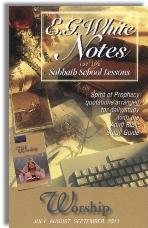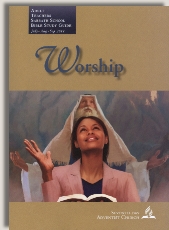|
||||||||||||||
Commentary on "Trust Not in Deceptive Words": The Prophets and Worship
Day 5: Wednesday, August 24, 2011 - Profitable for Nothing?
Overview
In today's lesson the biblical material for study is more extended than in the previous days. The entire chapter 44 from Isaiah is cited, a chapter that covers basically a long message from God on the futility of worshiping idols made by human hands—an irrational thing to do, but widespread nevertheless. Such idols are profitable for nothing in regard to spiritual present blessings for the soul and future blessings of resurrection and eternal life. In contrast with this valueless worship, the author alludes to Sabbath worship as offering God something solid, real, and profitable. The lesson ends with a warning formulated as a question for further reflection, bringing attention to the danger of making idols of one's church, pastor, or even personal piety and faithfulness.
Observations
It is highly probable, given the Adventist theological motivation for Sabbath-keeping, that the author wants to contrast the futile worship described by Isaiah with proper Sabbath keeping as the example of the true worship of God the Creator that gives hope for the future. While he's not explicit about this comparison, implicitly he makes this connection since he is writing to Adventists in their Sabbath School quarterly. The lessons are composed with a particular readership in mind—Adventists who believe worshiping on Sabbath is the way to worship the true God, the Creator. They also who see the worship practiced by Christians around them on Sunday as futile and unprofitable and even as a disaster for salvation—the mark of the beast. Chances are high that they will read into the Isaiah 44 description of idol worship a link with worship on the Day of the Sun, Sunday, a pagan practice in their minds.
What is missing from this picture is the fact that "Sunday worship" is related to the sabbatical pattern in a significant way that emphasizes the shadowy or typological nature of the Sabbath (Col. 2:16) and its fulfillment in the substance, Christ. There is not sufficient space to deal with the typological significance of the sabbath, but we will discuss one example briefly in order to point toward further study.
In the synagogue of Nazareth, Jesus announced His salvific mission as a fulfillment (Luke 4:21) of the year of the Jubilee. Isaiah's text which He had read talked about the "year of God's favor", the liberation of captives, things that marked the year of the Jubilee, when liberty was proclaimed to all people (Lev. 25:10). Jews who, due to poverty, became slaves or servants to their brothers, had to be released (Leviticus 25:39-41).
The passage in Isaiah, however, is not the single connection between Jesus' mission and the year of the Jubilee. The prophecy from Daniel 9 with the 70 sevens involves the jubilee pattern. The year of the jubilee was the fiftieth year, coming after seven series of seven years (Leviticus 25:8). The sabbatical pattern is clear: seven years leads to the sabbatical year, and seven sabbatical years lead to the year of the Jubilee. Both the sabbatical year and the Jubilee are closely connected in Leviticus 25, with the year of the Jubilee succeeding immediately after the presentation of the sabbatical year. Daniel 9 picks up this pattern: first, it talks about seven sevens (Daniel 9:25), and afterward about 70 sevens—ten jubilees—until a final atonement. Jesus comes as a fulfillment of this year of the Jubilee, the tenth in a sequence of Jubilees.
What is significant in the pattern of the year of the jubilee is that it came after the sequence of seven sabbatical years; it was not the 49th year, but the 50th, the next after it, a year that occurred outside of this cycle of "sevens", standing as a final end of a repeatable pattern. It fits very well with the finality of the atonement predicted in Daniel 9:24. Also the feast of booths, the feast that marked the end of the year for Jews, had a solemn assembly without work—not on the seventh day (as a typical sabbatical pattern will require), but on the eighth day, making a significant departure again from the repetitive cycle of sabbaths, as the year of the jubilee stands alone after each cycle of seven sabbatical years.
There are other significant typological links to the eighth day, or to the day that follows the sabbatical cycle, but the lesson that is significant comes from the fact that Sunday, as the eighth day, as the day that succeeds the sabbath, points to the fulfillment of the sabbath pattern, to the exiting from the repetitive cycle of Sabbaths, to the year of the jubilee and to the eight day of celebration at the end of the festival of booths, the day when the liberation was complete, the day when all dreams come true, when final atonement was made (Daniel 9:24). It points toward a finality and a move away from the shadow of the sabbath cycle, outside of a long path that led toward the fulfillment of the messianic promises.
The eighth day marks the coming of the final atonement, of a putting away of sin forever. It marked the end of the Feast of Booths which was ultimately fulfilled with the coming of the Holy Spirit ushering in the new covenant on the Day of Pentecost. There is no going back to the cycle that characterized the time of expectation, the time of longing for the day of redemption, the time of looking forward, the time of the shadows, the time when there was no finality and no final atonement.
Today is the final time, the time final atonement, the time of fulfillment, the time of the church—and these fulfillments are now signified by worshiping on Sunday, the eight day. The eight day is not holy; rather, it represents the One who is Holy—God the Son and the Spirit doing the work of the Father in all who believe in the Lord Jesus. The eight day—the day after the Sabbath—is a proper way to mark the exit forever from the cycle that characterized the times of the expectations.
Copyright 2011 BibleStudiesForAdventists.com. All rights reserved. Revised August 22, 2011. This website is published by Life Assurance Ministries, Glendale, Arizona, USA, the publisher of Proclamation! Magazine. Contact email: BibleStudiesForAdventists@gmail.com.
The Sabbath School Bible Study Guide and the corresponding E.G. White Notes are published by Pacific Press Publishing Association, which is owned and operated by the Seventh-day Adventist church. The current quarter's editions are pictured above.
Official Adventist Resources
Standard Edition Study Guide Week 9
Teacher's Edition Study Guide Week 9
Easy Reading Edition Study Guide Wk 9
Search the Complete Published Ellen G. White Writings
Please Support This Project


